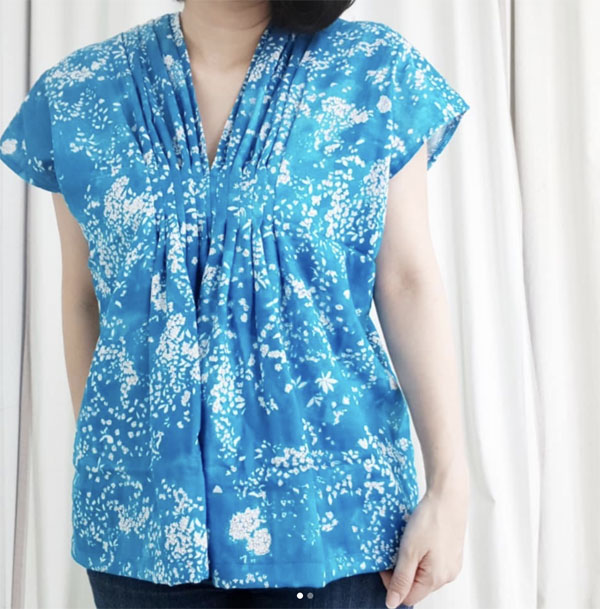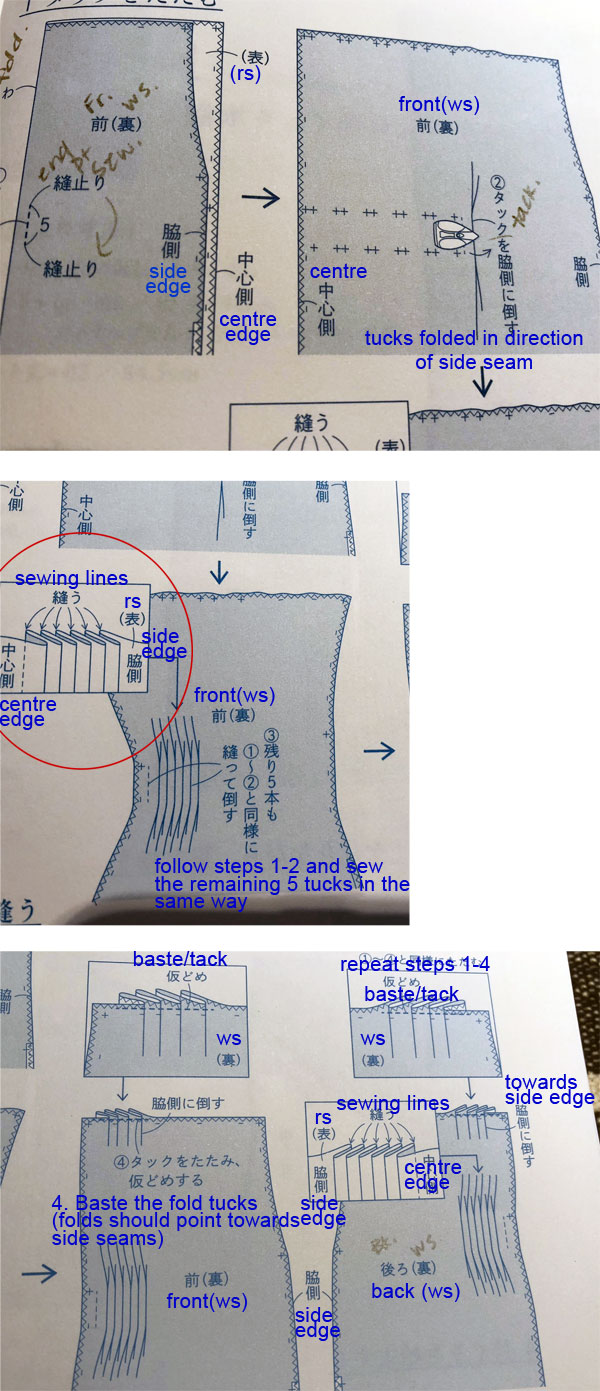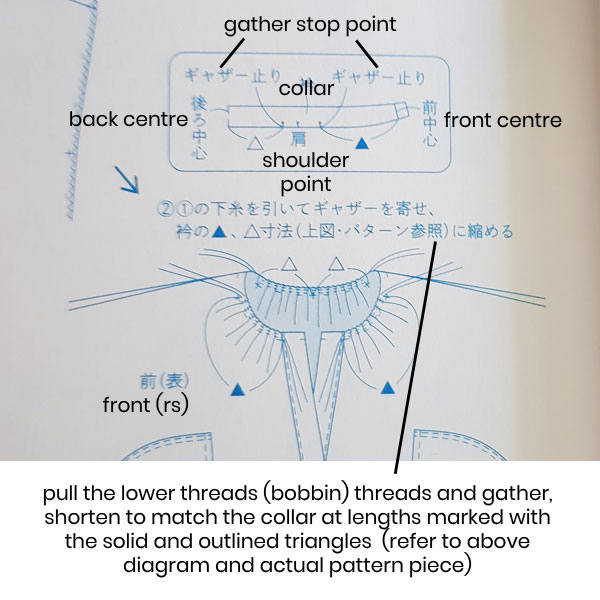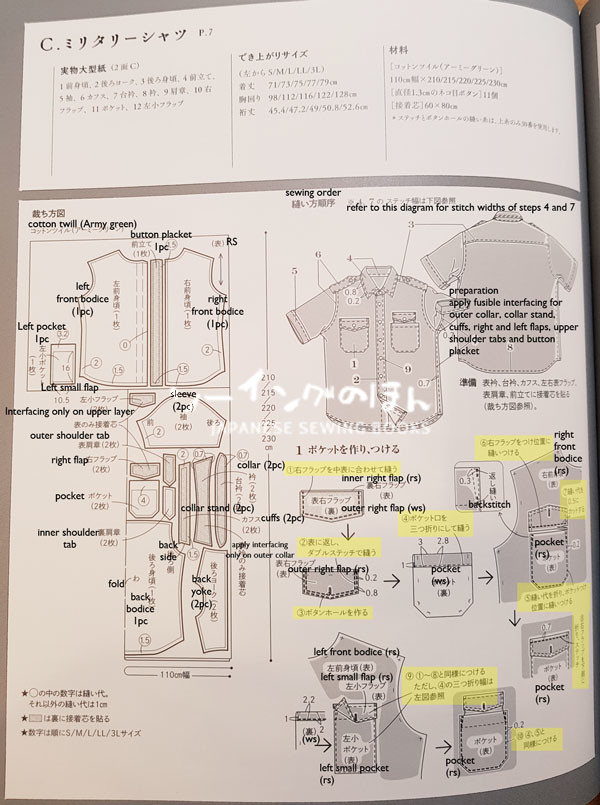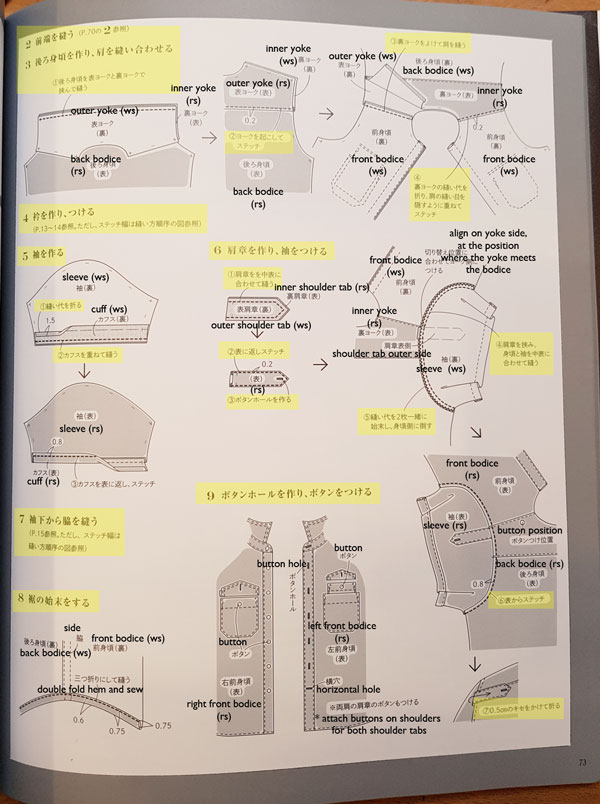Today’s translation request is from this book

For No. 2 Round collar Dress (which is also the dress featured on the cover)
I have translated the written instructions for Megan, instead of overlaying the text on the images because this pattern was 3 pages long and the words are tiny!
Here goes!
Completed dimensions (from left S/M/L sizes)
Length – 93.5 / 94.5 / 95.5cm
Back neck to cuff (along shoulder and down arm) length – 57.5/58.5/60cm
Materials *from left S/M/L sizes
Outer fabric
– p.10 C&S soft linen (navy purple)
– p.11 C&S half linen
– p.46 Linen Flannel
Fusible interfacing – 50x30cm
Stay tape – 1.5cm wide 34cm
Button – 1.1cm diameter x 3
Cutting layout
* Seam allowance is 1cm unless specified
* Cut bias according to dimensions in diagram
* dark grey shaded areas indicate area where stay tape should be applied
* light grey shaded areas indicate area where fusible interfacing should be applied
How to make
1. Attach back facing
1.1 Apply fusible interfacing to back facing
1.2 Fold in the outer curve of the seam allowance, and stitch.
(note on diagram – for curved portion, use a basting stitch to help pull it to a circular shape)
1.3 Align back bodice and back facing pieces, right sides facing, sew along the opening
(notes on diagram – use a narrow stitch length)
2. Sewing the shoulder seams
2.1 Zig-zag/serge the shoulder seams of each piece separately
2.2 With right sides facing, sew the front and back pieces together at the shoulder seam
2.3 Open up the seam allowance (iron)
3. Making the collar
3.1 Apply fusible interfacing to the wrong side of the outer collar, then, with right sides facing sew the collar pieces together along the outer circumference (except the neckline). Repeat for the other collar piece.
3.2 Trim the seam allowance to 0.5
3.3 Clip curves in the seam allowance, fold in the seam allowance, then turn right side out.
4. Attaching the collar
4.1 Make the bias (according to diagram)
4.2 Align the collar to the neckline, with the collar sandwiched between the back facing and bodice. baste in place
4.3 Align the creased line of the bias to the finished neckline, sew with a 1cm allowance from the neckline.
4.4 Cut the back opening (refer the diagram)
4.5 Trim the seam allowance of the neckline down to 0.6cm , clip curves in the seam allowance.
4.6 Turn the back facing right side out, and stitch down the facing piece (according to the diagram)
4.7 Foldover the bias to the wrong side of the garment (thereby enclosing the neckline) and stitch down (refer to diagram)
5. Attaching the side pockets
5.1 Apply stay tape to the wrong side of the front bodice pocket, zig-zag/serge along the seam allowance from sleeve down to the side (refer to point 1 on diagram step 6)
5.2 Zig-zag/serge the side seam allowance of the pocket piece
5.3 Attach the pocket pieces to the front and back bodice respectively (note the different seam allowances on the diagram). The front pocket should be sewn 0.3cm away from the finished line (side seam)
5.4 Flip the pockets to the right side and iron.
6. Sewing the underarm, side and around the pocket circumference
6.1 Sew the underarm – side seam, ending at the pocket opening, avoid sewing over the pocket pieces.
6.2 Open up the seam allowance (iron)
6.3 Top stitch the pocket opening from the right side (front only)
6.4 Sew around the circumference of the pocket fabric twice, then zig-zag/serge both seam allowances of the pocket pieces together.
6.5 For the back pocket, sew it down to the back seam allowance only (and not through the main fabric) to keep in place.
6.6 Sew the side seam allowances of the pocket fabric with a catch stitch (herringbone stitch) refer to pg 75 step 2 point 6
6.7 Lay the pocket towards the front bodice and stitch 2 or 3 times on the top and bottom edge of the pocket
7. Sewing the cuffs
7.1 Sew the cuff opening with a double fold hem
7.2 Sew a tuck 2cm from the shoulder (upper arm) seam
7.3 whip stitch to close the opening of the tuck
8. Finish the hem with a double fold hem
9. Attach the button to the back opening, make the loop (refer to p.83)
buy now from cdjapan.co.jp (affiliate link)
Title : Check & Stripe Handmade Simple Style
CHECK & STRIPE てづくりのシンプル スタイル
ISBN : 978-4-418-14425-9
Publisher : 世界文化社



